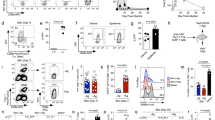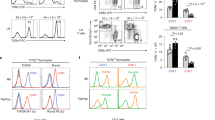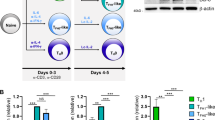Abstract
T-helper (Th) lineages have been generated in vitro by activating CD4 cells with anti-CD3/CD28 antibodies during polarization. Physiologically, however, the generation of Th lineages is by activation with the specific antigen presented by antigen-presenting cells (APC). Here, we used T-cell receptor (TCR)-transgenic mice to compare the phenotypes of Th1, Th9 and Th17 lineages when generated by either one of the two activation modes. Lineage Th cells specific against hen egg lysozyme (HEL), were adoptively transferred into recipient mice transgenically expressing HEL in their lens. Remarkable differences were found between lineages of Th1, Th9 or Th17, generated by either one of the two modes in their capacities to migrate to and proliferate in the recipient spleen and, importantly, to induce inflammation in the recipient mouse eyes. Substantial differences were also observed between the lineage pairs in their transcript expression profiles of certain chemokines and chemokine receptors. Surprisingly, however, close similarities were observed between the transcript expression profiles of lineages of the three phenotypes, activated by the same mode. Furthermore, Th cell lineages generated by the two activation modes differed considerably in their pattern of gene expression, as monitored by microarray analysis, but exhibited commonality with lineages of other phenotypes generated by the same activation mode. This study thus shows that (i) Th lineages generated by activation with anti-CD3/CD28 antibodies differ from lineages generated by antigen/APC; and (ii) the mode of activation determines to a large extent the expression profile of major transcripts.
This is a preview of subscription content, access via your institution
Access options
Subscribe to this journal
Receive 12 digital issues and online access to articles
$119.00 per year
only $9.92 per issue
Buy this article
- Purchase on Springer Link
- Instant access to full article PDF
Prices may be subject to local taxes which are calculated during checkout





Similar content being viewed by others
References
Zhu J, Paul WE . Heterogeneity and plasticity of T helper cells. Cell Res 2010; 20: 4–12.
Jiang S, Dong C . A complex issue on CD4+ T-cell subsets. Immunol Rev 2013; 252: 5–11.
Kanno Y, Vahedi G, Hirahara K, Singleton K, O'Shea JJ . Transcriptional and epigenetic control of T helper cell specification: molecular mechanisms underlying commitment and plasticity. Annu Rev Immunol 2012; 30: 707–731.
Noelle RJ, Nowak EC . Cellular sources and immune functions of interleukin-9. Nat Rev Immunol 2010; 10: 683–687.
Goswami R, Kaplan MH . A brief history of IL-9. J Immunol 2011; 186: 3283–3288.
Tan C, Gery I . The unique features of Th9 cells and their products. Crit Rev Immunol 2012; 32: 1–10.
Eyerich S, Eyerich K, Pennino D, Carbone T, Nasorri F, Pallotta S et al. Th22 cells represent a distinct human T cell subset involved in epidermal immunity and remodeling. J Clin Invest 2009; 119: 3573–3585.
Katz JD, Benoist C, Mathis D . T helper cell subsets in insulin-dependent diabetes. Science 1995; 268: 1185–1188.
Lafaille JJ, Keere FV, Hsu AL, Baron JL, Hass W, Raine CS et al. Myelin basic protein-specific T helper 2 (Th2) cells cause experimental autoimmune encephalomyelitis in immunodeficient hosts rather than protect them from the disease. J Exp Med 1997; 186: 307–312.
Riddell SR, Greenberg PD . The use of anti-CD3 and anti-CD28 monoclonal antibodies to clone and expand human antigen-specific T cells. J Immunol Methods 1990; 128: 189–201.
Kim SJ, Zhang M, Vistica BP, Chan CC, Shen DF, Wawrousek EF et al. Induction of ocular inflammation by T-helper lymphocytes type 2. Invest Ophthalmol Vis Sci 2002; 43: 758–765.
Iqbal N, Oliver JR, Wagner FH, Lazenby AS, Elson CO, Weaver CT . T helper 1 and T helper 2 cells are pathogenic in an antigen-specific model of colitis. J Exp Med 2002; 195: 71–84.
Trickett A, Kwan YL . T cell stimulation and expansion using anti-CD3/CD28 beads. J Immunol Methods 2003; 275: 251–255.
Shi G, Lovaas JD, Tan C, Vistica BP, Wawrousek EF, Aziz MK et al. Cell–cell interaction with APC, not IL-23, is required for naive CD4 cells to acquire pathogenicity during Th17 lineage commitment. J Immunol 2012; 189: 1220–1227.
Shi G, Cox CA, Vistica BP, Tan C, Wawrousek EF, Gery I . Phenotype switching by inflammation-inducing polarized Th17 cells, but not by Th1 cells. J Immunol 2008; 181: 7205–7213.
Tan C, Aziz MK, Lovaas JD, Vistica BP, Shi G, Wawrousek EF et al. Antigen-specific Th9 cells exhibit uniqueness in their kinetics of cytokine production and short retention at the inflammatory site. J Immunol 2010; 185: 6795–6801.
Lai JC, Fukushima A, Wawrousek EF, Lobanoff MC, Charukamnoetkanok P, Smith-Gill SJ et al. Immunotolerance against a foreign antigen transgenically expressed in the lens. Invest Ophthalmol Vis Sci 1998; 39: 2049–2057.
Chen J, Fujimoto C, Vistica BP, He J, Wawrousek EF, Kelsall B et al. Active participation of antigen-nonspecific lymphoid cells in immune-mediated inflammation. J Immunol 2006; 177: 3362–3368.
Heidel JD, Liu JY, Yen Y, Zhou B, Heale BSE, Rossi JJ et al. Potent siRNA inhibitors of ribonucleotide reductase subunit RRM2 reduce cell proliferation in vitro and in vivo. Clin Cancer Res 2007; 13: 2207–2215.
Rahman MA, Amin AR, Wang D, Koenig L, Nannapaneni S, Chen Z et al. RRM2 regulates Bcl-2 in head and neck and lung cancers: a potential target for cancer therapy. Clin Cancer Res 2013; 19: 3416–3428.
Biswas PS, Bhagat G, Pernis AB . IRF4 and its regulators: evolving insights into the pathogenesis of inflammatory arthritis? Immunol Rev 2010; 233: 79–96.
McGeachy MJ, Bak-Jensen KS, Chen Y, Tato CM, Blumenschein W, McClanahan T et al. TGF-beta and IL-6 drive the production of IL-17 and IL-10 by T cells and restrain TH-17 cell-mediated pathology. Nat Immunol 2007; 8: 1390–1397.
Davidson TS, DiPaolo RJ, Andersson J, Shevach EM . Cutting edge: IL-2 is essential for TGF-beta-mediated induction of Foxp3+ T regulatory cells. J Immunol 2007; 178: 4022–4026.
Jager A, Dardalhon V, Sobel RA, Bettelli E, Kuchroo VK . Th1, Th17, and Th9 effector cells induce experimental autoimmune encephalomyelitis with different pathological phenotypes. J Immunol 2009; 183: 7169–7177.
Veldhoen M, Uyttenhove C, van Snick J, Helmby H, Westendorf A, Buer J et al. Transforming growth factor-beta ‘reprograms’ the differentiation of T helper 2 cells and promotes an interleukin 9-producing subset. Nat Immunol 2008; 9: 1341–1346.
Acknowledgements
We thank Robert S Lee for tail DNA analysis, Samuel J H Hinshaw for digital microphotography, Rafael Villasmil for cell sorting and the NEI Histology Core Facility for tissue section preparations. This work was supported by the Intramural Research Program of the National Eye Institute, NIH.
Author information
Authors and Affiliations
Corresponding author
Rights and permissions
About this article
Cite this article
Tan, C., Wei, L., Vistica, B. et al. Phenotypes of Th lineages generated by the commonly used activation with anti-CD3/CD28 antibodies differ from those generated by the physiological activation with the specific antigen. Cell Mol Immunol 11, 305–313 (2014). https://doi.org/10.1038/cmi.2014.8
Received:
Revised:
Accepted:
Published:
Issue Date:
DOI: https://doi.org/10.1038/cmi.2014.8
Keywords
This article is cited by
-
The development and in vivo function of T helper 9 cells
Nature Reviews Immunology (2015)



